There is a vogue right now for a practice called Kinbaku or Japanese Rope Bondage. It involves a mainly public display of clothed and naked women being tied in elaborate ways with metres and metres of natural rope, bound, wound and knotted into tortuous configurations and often suspended above the ground. The interest in this particular fetish has breached the normal boundaries of niche pornography and entered the sphere of contemporary art and culture, whilst sidestepping the obvious bourgeois objections to the objectification, not to say public humiliation of women. The exact status of Kinbaku is hard to quantify; a Google search will lead you to as many porn sites as art galleries or festivals of mind and body… so what, if anything, is there to find in this practice other than titillation?
Most fetishes gain cultural credibility from association (with someone or something avante-garde or famous in an intellectually respectable field), or historical pedigree. Kinbaku has a little of both, although these credentials, as we shall see, are somewhat misplaced. Looking at the two woodblock prints on this page (available from Toshidama Gallery) and comparing them to a contemporary bondage photograph, there seems to be a direct correlation between the nineteenth and the twenty-first century imagery but I think that this connection is tenuous and manipulated. The prints depict different heroines albeit in identical poses. The print above, by Yoshitoshi, is an historical print showing the maid Muraoka tortured by the state for supporting Nationalist revolt in 1858. The print on the right by Kunichika, depicts the servant Okiku suspended in a well by her wicked employer for allegedly breaking a valuable plate,
a role played by Onoe Baiko in the play of the subject where he takes the female role. The Baiko seems to me to be absent of the sexual suggestiveness inherent in the former image. There is an argument that prints such as the Yoshitoshi give historical precedence to the modern practice of Kinbaku, but this is not quite the whole case. Some men have always been fond of packaging and tying up women. The photograph to the left is of an English woman in a corset from roughly the same date as the two prints (late nineteenth century). Admirers of Kinbaku suggest that the art of rope bondage is intimately associated with the aesthetic of the Japanese and their delight in packaging, containing, nature. Examples might be the tightly bound food in bento boxes or origami or the formal tying of kimono or ceremonial wear; but then when one examines the extremely complex knotting of an English admiral’s dress uniform or the lacing of a woman’s corsets, the cultural argument becomes less convincing.
I’m being coy here… there is clearly a pornographic (and sadistic/violent) element to Japanese rope bondage, but there is also a beauty and formality to it as well. It is understandable that cultured people should be attracted to restrained (and restraining) practices which create a tension between nature and discipline. There is the same aesthetic at work in eighteenth century formal gardens or romantic neo-classical painting. It becomes problematic I think, when the enthusiasm for the exotic, clouds judgement about the real content, motive or effect that an image or a performance might suggest.
A few prints by Taiso Yoshitoshi are probably the only example of Japanese bondage that I can think of that predates the Second World War – it simply does not exist as a sexual motif in Japanese art or imagery prior to that. Most people are familiar with shunga (the japanese art of explicitly pornographic woodblocks) but shunga rarely illustrates sexual acts beyond the relatively conventional and certainly not bondage in any form. From that alone, one would have to conclude that the sexualized binding of women was no part of Japanese consciousness at all… apart from the case of Yoshitoshi. Perhaps one of the greatest and most disturbing images of Japanese art is Yoshitoshi’s vertical diptych The Lonely House on Adachi Moor. Here we see a heavily pregnant girl, tied and bound and suspended by her feet with a hag sharpening a blade beneath her. There is some resemblance here to contemporary Kinbaku imagery, but there is none of the fastidious attention paid to knots and ties, and it has to be borne in mind that Yoshitoshi is known to have been a singularly disturbed individual even to his own contemporaries – not for nothing is the standard text on the artist subtitled Beauty and Violence.
If not from Edo culture then, where does the current vogue for ritual, sexualised binding originate? Many people claim that Kinbaku is derived from Hojojutsu, a sophisticated method of restraint, used for the transportation, exchange and confinement of prisoners of both sexes during the Tokugawa Shogunate in Japan. There is something to be said for the argument that the Japanese have a tradition of binding and wrapping, but the complex system of ropes and ties used in Hojojutsu most likely came about through the necessity of rapid prisoner exchange at borders and the need in such a hierarchal society as Edo Japan to mark the difference between different classes of prisoner and different genders. It was not until the early twentieth century that Seiu Ito, (credited with being the effective inventor of Kinbaku) whilst researching Hojojutso happened upon the idea of refining it into a sexual aesthetic. His personal obsession with Yoshitoshi led him to subject his pregnant wife to the tortures depicted in the print of the Lonely House and his subsequent photographic and drawn depictions really form the basis of the entire practice. The vogue for Kinbaku took hold in America in the 1950’s where a combination of the mystery of the East and traditional misogyny have made it popular with both pornographers and BDSM aficionados.
It is a complicated history of half truth and fact. Some people, feminists especially, will find the practice and depiction deeply offensive, others will see a discipline and otherness that they find inspiring and some will see a powerful sexual stimulus… either way, it seems there’s no great sexual tradition for this in Japan, although the originator of the entire movement, by default turns out to be Taiso Yoshitoshi after all and his troubled relationship with beauty and violence.
I recently had the pleasure of having dinner with Midori, one of the leading exponents of Kinbaku in the west. Half Japanese herself, she acknowledges the sexual element as well as the ritualised nature of the practice and uses men and women in her performances. For anyone interested in exploring the subject more, I recommend both her books on the subject and her website, which can be found at Planet Midori.

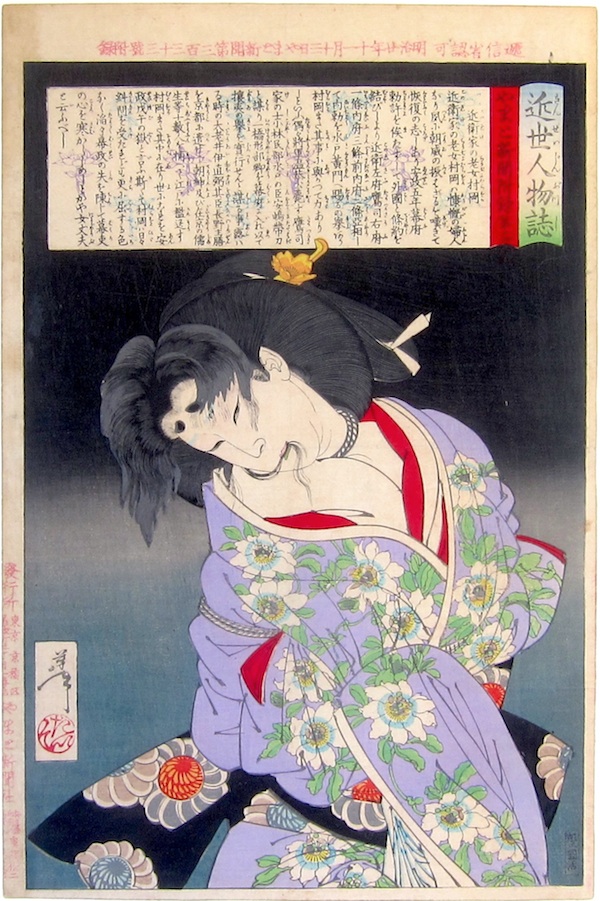
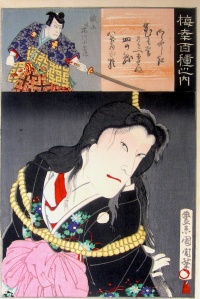

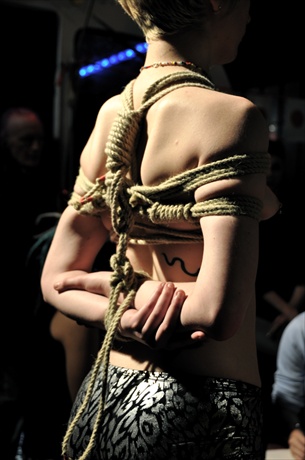
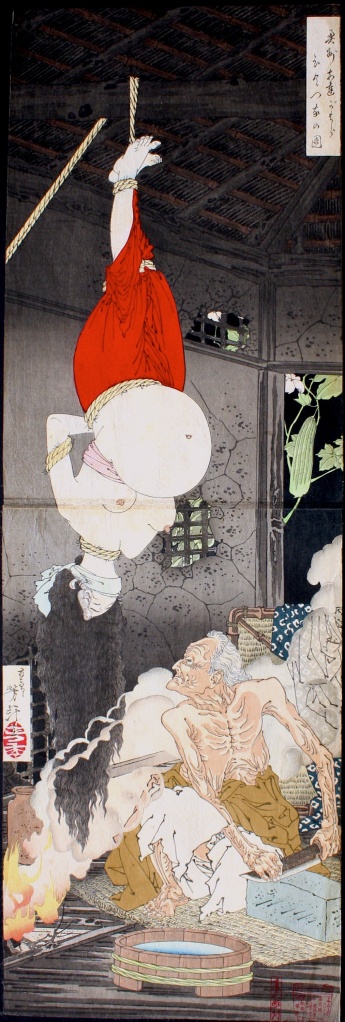
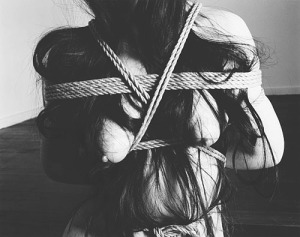
Interesting blog post. I’ve seen that Yoshitoshi print before at an auction preview in Japan. Quite disturbing, but it captures your attention. Nobuyoshi Araki has a famous series of photographs covering the subject and also called Kinbaku.
Actually, there is one example of shunga that I’m aware of that includes bondage. It’s a scene over four pages in Ehon futamigata by Hokusai that shows a bandit raping a victim’s wife (both tied up), with the husband just as aroused as the bandit in the process. Here is a picture: http://is.muni.cz/do/1499/el/estud/prif/ps09/kruh/web/pics/16-japonsko/16-30.jpg
Hi
Thanks for that. I haven’t seen this print before though it prompts a memory of a similar subject, but even so I think these subjects are rare in ukiyo-e art and Kinbaku remains a fairly modern phenomenon.
Any idea what it fetched?
Pingback: Beauty and Violence: Kinbaku, The Art of Japanese Rope Bondage | Modern Tokyo Times
Very interesting. Do you mind if I blog and link back? I think that might actually be a photo of my Adachi Moor 🙂 Here’s a bit about it http://esinem.com/articles/other/finding-the-lonely-house-on-adachi-moor and http://esinem.com/articles/ramblings-of-the-house-on-adachi-moor
Very, very interesting post. Did you happen to draw upon any scholarly sources for your ideas?
Pingback: How A Friday Night Walk Led To Researching Japanese Rope Bondage *Viewer Discretion Advised* | nchiiwat
whoah this weblog is fantastic i love studying your articles.
Stay up the great work! You realize, lots of persons
are looking round for this information, you could aid them
greatly.
Thank you! It’s always good to know people like what you are doing!
Pingback: Classical Martial Arts Research Academy | Hojojutsu 捕縄術 The Science of Rope Arresting
Pingback: Hojojutsu 捕縄術 The Science of Rope Arresting – Classical Martial Arts Research Academy